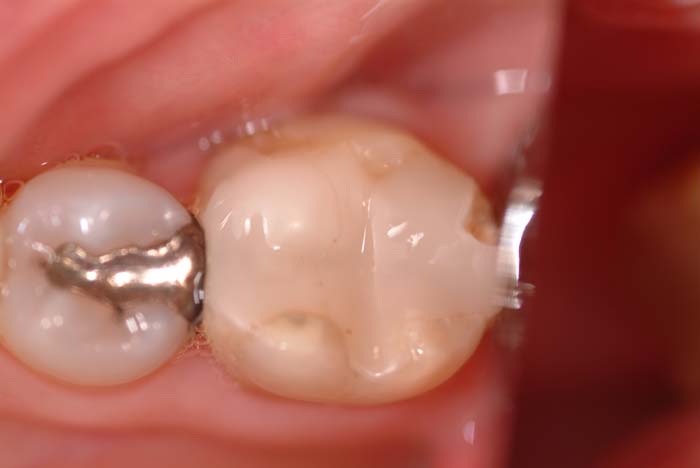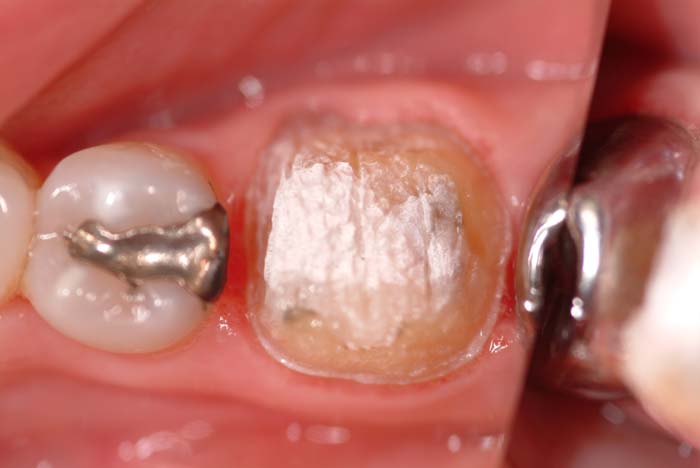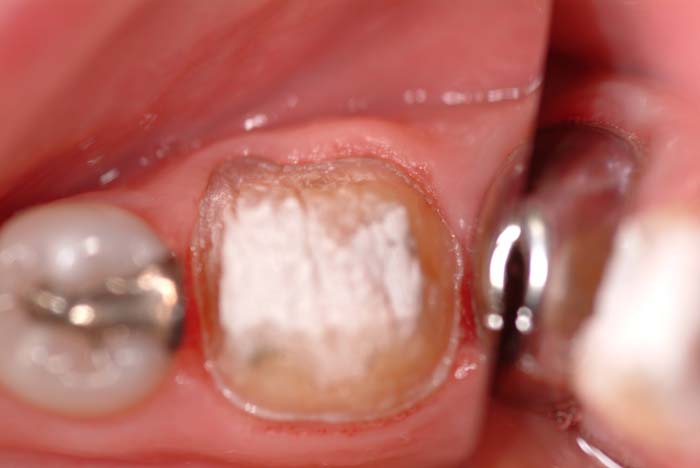Forum Replies Created
-
AuthorPosts
-
AnonymousParticipantGlenn,
I’ve had mixed results.
Pretty effective using .25w 0/0 starting defocused and circling inward until pt feels it. If I can get close enough to see some surface change, then sensitivity stops in alot of cases(especially those max 1st molars w/ buccal tooth brush abrasion).
The most disappointing are those pts I’ve sent previously to the periodontist and now have 2-3 mm pockets but have to drink everything thru a straw. I’ve tried to do just a few teeth at a time but it seems the sensitivity comes from everywhere on those teeth. I think in light of the Fluoride discussion in another thread I might try some topical fluoride and lase that and see what happens.
PatricioSpectatorMark,
I completed my first laser crown prep today, well almost completed one. I finished it with the usual burs etc.
I am glad I do not have my photo system operational as my tooth did not look near as nice as Al’s. Part of the tooth looked a little bit like the Rocky Mountains and I had a little trouble with estimating the depth on the facial and lingual and of course I lacked a plan of attack. It was exciting and I can see better things to come.
What are you doing to smooth out the rough and irregular surface? Is there a preferred stepwise plan of attack? Tip? Are the white pocked margins on the shoulder a problem at the lab?
I had a hypersensitive patient today. I “Anesthestized” the tooth at 6W for 45 seconds on a lower first molar and he kept jumping when the laser touched his tooth as the cervical facial (4w). Does a second “anesthetic” prep of 45 seconds usually help? It did not help in this case. Is this a time for the local anesthetic? He did better with a number 2 round bur by the way.
When I use the laser to trim back tissue around a crown prep I get white pocking on the prep margin. Is this a concern?
Any help you or anyone can give will move the mission and be appreciated.
Thanks,
Pat
PatricioSpectatorGlenn,
A recent article by Ron Kurthy(?) sorry Ron on the spelling, states that a product like Touch and Bond will seal up the tubules and that’s it. I have a lady coming in in the next couple of days with serious sensitivity. I thought I would try the bonding on one side and the laser on the other to see what results. I have had dependable results from the laser but not necessarily complete elimination of sensitivity in all cases.I have noted the patient usually feels the 0.25W but saw that as a negative and backed off. As you indicated Ron maybe this is the feedback of successful sensitivity reduction in that area.
Pat
2thlaserSpectatorGreat job Pat! Congrats on your boldness to move forward. I hope it was easier than you thought it would be. To answer some of your questions, the best I can…
“What are you doing to smooth out the rough and irregular surface? “
If you angle the tip, so you “shave” the tooth on very low power, around 1.25-2.25W with 40%air, 20-30%water, you can smooth it that way, which is the way I did it. You can actually see the shaving taking place. We are developing new tips to try to acheive this, but I don’t have em yet!
“Are the white pocked margins on the shoulder a problem at the lab? “
No they are not, again, lower the wattage to 1.25 or less with 30%air and 20% water to acheive margination, it was surprising how well this worked for me. The lab has had zero problems finding and getting great margination for me.
“I had a hypersensitive patient today. I “Anesthestized” the tooth at 6W for 45 seconds on a lower first molar and he kept jumping when the laser touched his tooth as the cervical facial (4w). Does a second “anesthetic” prep of 45 seconds usually help? It did not help in this case. Is this a time for the local anesthetic?”
First of all, I recommed at least 90 sec anethesia time, not 45 seconds. Also, on a cervical area, you really need not have your settings any higher than 1.25-1.75W with low air and water. It usually is a very sensitive area anyhow, lower settings usually work much better in that area. 4W in my estimation would be way too high. One of the things I have learned from Bob Gregg, Glenn Van As and Stu Rosenberg is that the lower the power you can use, the better in most cases for all procedures. I only use higher wattage when I am anesthetizing and JUST getting into the enamel on a class I or II. As far as using a local, you could have, but I think if you decrease your power settings, you would have success.
“When I use the laser to trim back tissue around a crown prep I get white pocking on the prep margin. Is this a concern?”
It can be. Make sure you are angulating your tip correctly, it is END cutting so you should not get any collateral effect if the angulation is correct. That is my experience so far. In addition, I use a T-6 tip to trough, I like it better. I can use less energy, usually .25-.5W with 11%air and 7%water, it’s only 200 microns so it’s smaller, with less chance of collateral damage even it the tip isn’t angled quite the right way.
I sure hope I have helped you see a few things. I am no expert, but I DO try a ton of things everyday. I learn more from all of you everytime I read something here, so if I can pass a tidbit along once in a while, it makes me feel like I am contributing.
BTW, I removed an amalgam yesterday, without local, did what you guys have been teaching ME, and it worked like a charm. Used the high speed, after anesthetizing, and then back to the laser to finish, the patient thought it was way cool, and then his wife came in later that day and said he couldn’t stop talking about it! How’s that for internal marketing!!! Love that laser!!
Mark
2thlaserSpectatorHey guys,
In my experience, if you do what Ron suggests, .25W with 0/0 air and water, you actually close the tubules. BUT one must start much further away, as the laser energy causes heat buildup w/o air and water. You can use a little air at times, maybe 10%,but that in itself can be sensitive to the patient. I have had great success, and without adding a bonding agent, unless it is an abfraction area, then I bond to it.Again, most importantly, DO NOT START OUT VERY CLOSE TO THE SURFACE OF THE TOOTH. I start out 10-15mm away, and VERY SLOWLY bring the tip closer, and I ask the patient what if anything they are experiencing. I really haven’t “hurt” anyone to date doing the procedure in this manner, Ron, how bout you?
Mark
AnonymousParticipantQUOTEAgain, most importantly, DO NOT START OUT VERY CLOSE TO THE SURFACE OF THE TOOTH. I start out 10-15mm away, and VERY SLOWLY bring the tip closer, and I ask the patient what if anything they are experiencing. I really haven’t “hurt” anyone to date doing the procedure in this manner, Ron, how bout you?
MarkI second the notion of starting a long distance away and to also always keep the tip moving. I usually tell the patient that as soon as they start to feel it get warm to raise a hand so I can back off. I tell them I need to have them feel this to know we’re getting the actual sensitive area. Once backed off I pause a few seconds and get the patient to run their tongue over the area. Then I start circling in again.
I have had 1 person (20 buccal, cervical) who couldn’t stand even .25 0/0 from any closer than the 10mm-he said this hurt and I could tell it wasn’t acting on his part.Couldn’t even rinse with tap water it was so touchy. Just decided to numb him up- infiltrated some Septocaine and finished with the laser.
gwmilicichSpectatorRon
Triage has a very high F level (6 times that of Fuji 9)
Personally, I can’t see there being any benefit in hitting it with the laser. The reaction you are looking for is related to polyacrylic acid etching the enamel and creating a hybrid zone on teh surface incorporating teh Ca and Phosphates from both the tooth and the GIC, plus incorporating the F from the GIC.The colour is pink so when you hit it with a blue light, it absorbs the photonic energy , warms up and speeds up the chemical reaction that is occuring.
The laser would only be hitting 600micron spots rather than the whole restoration. By the time you ocvered it all, it would be set all on its own. Plus the Waterlase gets its knickers in a twist on GIC’s Too much metal content I think.
Other laser applications using F have not had the complexity of what is already happening when you put GIC onto the tooth and act as an adjunct to F uptake. I doubt this would be the case with GIC’s
Just my thoughts anyway, but I could be wrong.
Cheers
gwmilicichSpectatorI am going to try and cover some applications of the Laser in Microdentistry at Dana Point. Things like slot preps, tunnel preps, where AA works in conjunction with the Laser plus some booby traps when applying AA type Microdentistry concepts to the Laser
Cheers
AnonymousParticipantThanks Graeme,
That makes alot of sense.
2thlaserSpectatorGraeme,
I can’t wait! Should be great learning!
Thanks,
Mark
Robert Gregg DDSSpectatorHi Guys,
Everything you all have said is consistent with our long-time clinical experiences and observations.
What we have concluded from both defocused and contact techniques is that starting defocused and NOT numb and moving and observing patient response is nearly always successful in reducng sensitivity; whereas working numb and in contact was much more unpredictable.
Lasing “out” to “in” = 90%+ effectiveness
Lasing “in” and “on” = 50% effectiveness.That led us to conclude emperically that dentinal hypersensitivity is BOTH a phenomenon of irritation of the odontoplastic processes AND non-occluded tubules. Because if all we do is try to occlude the tubules, we get mixed results. If we address the odontoplastic processes in a defocused mode, THEN move in and alter the dentin surface, we are much more effective.
But trying to get in contact on the distal CEJ or further interproximal can be real tough! Hence incomplete treatment and results….thus the 90% rule.
The 90% Rule:
We have observed that patients cannot perceive a reduction in sensitivity unless it is reduced AT LEAST 85% to 90%.
We were able to document as much as 80% reductions in pain response PER TOOTH, but when they drank cold water or sucked in air, they perceived NO change!!!:shocked:
This led us to conclude that dentinal hypersensitivity is an ALL or NONE response. If we don’t remove ALL of the contributing factors–we get very mixed and disappointing results.
So, what we do now is establish a baseline of response with the patient and DOCUMENT it in the chart. What I typically do is take an air syringe and explain to the patient that I am going to make a quick air test to measure and grade their senstivity/pain on a scale between 1 and 10, with 10 being unbearable pain. I do a sample test on the back of their hand to prepare them for how quick it will be.
Usually I get a report of 8-10. Then I go through a defocused method as Mark and Ron described very well. Then I re-test and record the patient’s report. Usually they are in the 2-3 range, sometimes better. Excellent tool for tracking results.
Now all you smart Beamers should be thinking, “Well, did we reduce sensitivity or just create analgesis/anesthesia in the teeth. The answer is YES! You did both.
Now the last thing to get you all as close to 100% success is to make sure that ALL occlusal trauma has been removed from the offending teeth–INCLUDING those teeth who’s gums have been amputated by the periodontist! Don’t ignore the role of occlusal insult to the very tender pulp.
Now to get you all bright beamers thinking even more, at some point you will realize that in the use of lasers to calm pulps down, you also have an VERY sensitive instrument for PULP TESTING…….any thoughts on how?:biggrin:
Bob
PS: Glenn–I appreciate you commnet from your periodontist, but I take exception to what your periodontist said. I have never heard anyone suggest that covering the roots with grafts is SOC. If that were so, then why do they routinely remove tissue in “push-back” and ressective perio disease tx procedures as Ron described? I will check the perio references I have for their SOC position paper. I don’t think they have one!?
AnonymousParticipantGreat post bob , thanks for sharing , challenging and teaching.
QUOTEQuote: from Robert Gregg DDS on 10:23 am on Dec. 12, 2002[br}Now to get you all bright beamers thinking even more, at some point you will realize that in the use of lasers to calm pulps down, you also have an VERY sensitive instrument for PULP TESTING…….any thoughts on how?:biggrin:
Here is 1 proposed method http://www.karna-ddscomfordent.com/LLLT-2.htm. I haven’t done this mainly because I was concerned (that using the diode and its absorption by pigment) about the tissue effect from tissue surface to the apices. I also thought 15-20 seconds of stimulation in 1 area w/o moving seemed quite long. Why direct at apices (and overlying tissue)and not pulp chamber itself? I also couldn’t find anything that supported this method.
2thlaserSpectatorHere is some newer pictures of a molar crown prep I did today, all laser, no rotary instrumentation. This is the preop with large composite filling with broken distal marginal ridge.

Next are the “depth cuts” I make, which are about 1.5-2mm in depth, from the buccal over the occlusal, to the lingual.

Then, here is a picture of the occlusal table, notice the “frosting” of the composite. This all took about 10 minutes for the prep. I tried a slightly different method to create the interproximal margins this time…I will try to explain.

What I did was prep the interproximal by making a “slice” just short of the “gingival floor”, then taking a hand instrument, I broke out the thin layer that was left, and it established the initial “shoulder” of the margin. I then lowered my power to 1.25W 40%air 25%water to refine the margins and smooth the prep. Again, I don’t mind the “roughness” that some people like to smooth. I like the idea of the greater surface area I have to bond with my GI cements….Rely X.

The hard part on this prep was the MB area, where there was some root exposure, so I had to bring the margin down on that area, rather than a straight around the tooth, same level margin that I am used to fabricating. It worked great. I was in a hurry, so hopefully the pictures are ok. I just want to show you how I TRY to do this w/o rotary instrumentation. What other recommendations would you all have to improve this technique? Just wondering. Always looking to learn!
Thanks,
Mark
PatricioSpectatorMark,
You are a great help. I know I was suprised at how fast I preped with the laser and I see from the pictures I was about right in my procedure. I will add your suggestions. I suspect you will talk about this at Dana point and thought it would be good to do one or two before I get there. The desensitizing method for the cervical makes good sense and I will try this.
Completed four restorations on a three and a half year old today. No problem. Her mother was impressed.
A fellow came in because of a lost filling which was actually enamel fracture around decay. I cleaned it out with the laser and placed a temorary as we planned for a crown( another new patient arrives). As he was leaving he said his son had been to the dentist two days before and had two cavities and he wanted to know if he could bring him to our office for laser care. I won’t be high on that dentist’s list.
I find myself roughing up the abutment prior to cementation for sterilization but also for retention on short crowns. What do you think? Where is Whitefish I couldn’t spot it on a travel map? But then I just discovered that you need to click on page two and three if you want to read those messages.
Pat
Glenn van AsSpectatorNeat pics Mark……….I tell you I dont have the patience you do for doing the crown.
I will be VERY interested to see if you thoughts change once you start looking through the scope at the roughness of the preps.
I think it is great that you are doing these, did you anesthetize this one.
Thanks for sharing , by the way I changed my last lecture from the erbium not being good for crown preps to it is possible if you desire to take the time and you accept the little bit of roughness, and if not you can smooth it out with a bur.
Thanks for posting those pics……..great stuff.
Glenn
-
AuthorPosts
